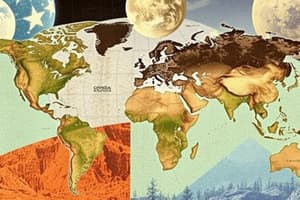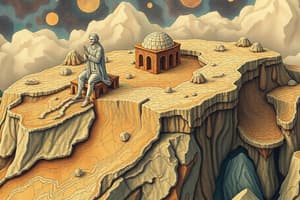Podcast
Questions and Answers
What is the largest continent in the world?
What is the largest continent in the world?
- Asia (correct)
- Africa
- Antarctica
- North America
Which ocean does the Colorado River flow into?
Which ocean does the Colorado River flow into?
- Atlantic Ocean
- Arctic Ocean
- Pacific Ocean
- Gulf of Mexico (correct)
How many physical divisions are there in North America?
How many physical divisions are there in North America?
- 5 (correct)
- 7
- 6
- 4
In which climate zone are winters very long and cold while summers are short and cool?
In which climate zone are winters very long and cold while summers are short and cool?
What is true about the currents that increase the temperature of coastal areas?
What is true about the currents that increase the temperature of coastal areas?
Where are Taiga forests primarily found?
Where are Taiga forests primarily found?
Which statement correctly describes the intermountain plateaus?
Which statement correctly describes the intermountain plateaus?
What type of trees primarily make up the Taiga region?
What type of trees primarily make up the Taiga region?
Which of the following accurately describes the total number of continents recognized?
Which of the following accurately describes the total number of continents recognized?
Which ocean is located to the east of Africa?
Which ocean is located to the east of Africa?
Which statement is true regarding Africa's geographical placement?
Which statement is true regarding Africa's geographical placement?
Which of these continents is situated to the northwest of the Ural Mountains?
Which of these continents is situated to the northwest of the Ural Mountains?
What is a characteristic of the continent of Asia?
What is a characteristic of the continent of Asia?
Which ocean is situated to the west of Africa?
Which ocean is situated to the west of Africa?
Which of these facts is incorrect regarding North America?
Which of these facts is incorrect regarding North America?
Which of these formations is primarily responsible for the physical geography of South America?
Which of these formations is primarily responsible for the physical geography of South America?
Minerals can be found naturally in which of the following?
Minerals can be found naturally in which of the following?
Which statement is true about rocks that contain minerals?
Which statement is true about rocks that contain minerals?
What is the primary characteristic of metallic minerals?
What is the primary characteristic of metallic minerals?
Which mineral is primarily extracted from bauxite ore?
Which mineral is primarily extracted from bauxite ore?
Which of these is a true statement about non-metallic minerals?
Which of these is a true statement about non-metallic minerals?
What is the largest producer of iron ore in the world?
What is the largest producer of iron ore in the world?
Which type of mineral is primarily extracted from sedimentary rocks?
Which type of mineral is primarily extracted from sedimentary rocks?
What is the rank of India in global mineral production?
What is the rank of India in global mineral production?
Flashcards are hidden until you start studying
Study Notes
Continents
- A continent is a large body of land, usually separated by water or by mountains.
- There are 7 continents.
- There are 5 oceans.
- Asia is the largest continent.
- The Ural Mountains separate Asia and Europe.
- Africa is the second largest continent.
- Africa is surrounded by the Mediterranean Sea in the north, the Atlantic Ocean in the west and the Indian Ocean in the east.
- North America is not the oldest continent.
Minerals
- Minerals are substances that can be found naturally in Earth.
- Rocks that contain minerals are also called ores.
- There are 3 types of minerals.
- Iron is a metallic mineral.
- Metallic minerals can be melted to make new products.
- Metallic minerals are hard.
- Metallic minerals are mostly found in igneous rocks.
- India is the third leading producer of bauxite in the world.
- Gold is found in Kolar mines of Karnataka.
- Non-metallic minerals are substances from which new substances cannot be made.
- Non-metallic minerals are found in sedimentary rocks.
- Non-metallic minerals are breakable.
- Non-metallic minerals have no shine or luster of their own.
- There are 3 ways in which coal is mined:
- Strip mining
- Open-cast mining
- Deep mining
- In strip mining, coal is collected from just under the surface.
- In deep mining long tunnels are dug in order to reach the coal.
- An oil field is an area where there are many wells.
- Petroleum is also a fossil fuel.
Resources
- The United States of America is the leading producer of natural gas and petroleum.
- The process of taking out minerals from the earth is called mining.
- Surface mining is done by clearing surface vegetation and dirt.
- Underground mining is also called sub-surface mining.
- Hydro-electricity refers to electricity generated by hydro power.
Studying That Suits You
Use AI to generate personalized quizzes and flashcards to suit your learning preferences.




